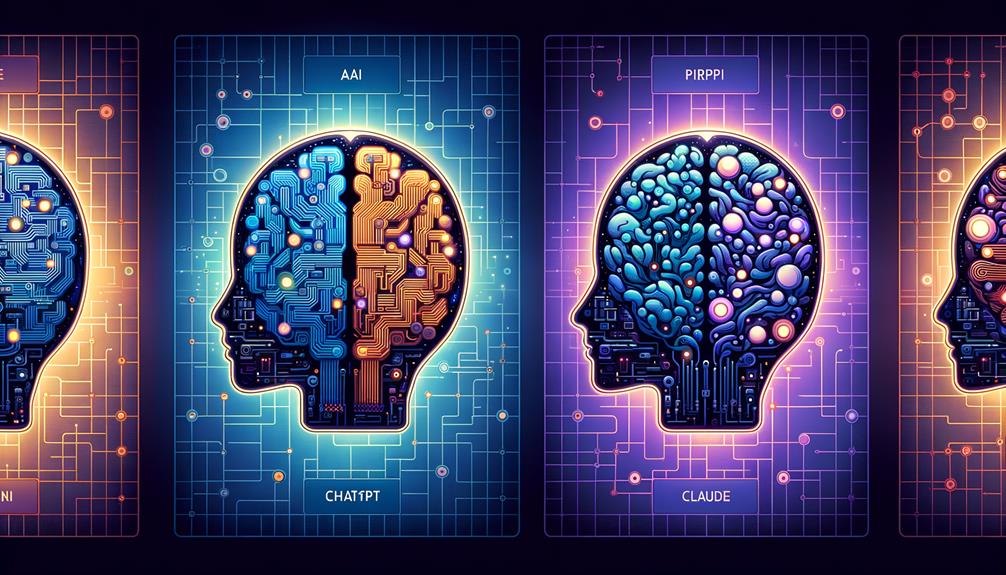

Vous comparez probablement ChatGPT, Claude et Perplexity pour déterminer le meilleur modèle d'IA pour vos besoins. Chacun d'entre eux excelle dans les domaines suivants domaines spécifiques: Perplexity est idéal pour la recherche et l'analyse de données, ChatGPT brille dans la rédaction de courriels et la création de contenu pour les médias sociaux, tandis que Claude domine les applications conversationnelles. Pour choisir le bon outil, vous devez comprendre leurs caractéristiques. des atouts distincts et les capacités. Bien que ces trois modèles présentent certaines similitudes, leur principaux cas d'utilisationles styles d'interaction, et caractéristiques principales diffèrent grandement. En explorant ces différences, vous découvrirez le modèle qui répond le mieux à vos besoins spécifiques et vous exploiterez tout le potentiel de l'IA.
Lors de l'évaluation Modèles d'IAVous constaterez que chacun d'entre eux excelle dans les domaines suivants des cas d'utilisation primaires distinctsLa compréhension de ces points forts est essentielle pour choisir l'outil le mieux adapté à vos besoins.
Vous recherchez un intelligence artificielle[1] qui correspond à vos objectifs, et le fait de savoir où chaque modèle se distingue peut faire toute la différence.
Perplexity AI est votre interlocuteur pour recherche et analyse de données, en fournissant des informations précises, informations citées à la source parfait pour les contextes académiques et professionnels.
ChatGPT, quant à lui, est un outil polyvalent qui permet de rédiger des courriels, de créer du contenu pour les médias sociaux et de s'engager dans des discussions sur des sujets d'actualité. client[2] service.
En attendant, Claude domine les applications conversationnelles et l'engagement des utilisateurs, ce qui lui vaut le titre de "roi du contenu".
La comparaison des styles d'interaction des modèles d'IA révèle des points forts distincts, chacun excellant dans sa manière unique d'impliquer les utilisateurs et de fournir des informations. Perplexity AI met l'accent sur les interactions structurées et centrées sur l'information. En revanche, ChatGPT brille par son style conversationnel, tandis que Claude se concentre également sur l'IA conversationnelle. On constate une nette différence dans la manière dont chaque modèle aborde le dialogue.
| Modèle d'IA | Style d'interaction |
|---|---|
| Perplexité AI | Structuré et centré sur l'information |
| ChatGPT | Conversation et ressemblance avec l'homme |
| Claude | Conversation avec une approche de dialogue unique |
Vous remarquez que le style d'interaction de chaque modèle est conçu pour exceller dans des domaines spécifiques. En comparant ces styles, vous comprenez mieux comment chaque modèle peut répondre à vos besoins particuliers.
En explorant les principales caractéristiques et capacités des différents modèles d'IA, on constate qu'ils présentent des points forts qui les distinguent les uns des autres sur le plan des fonctionnalités et de l'expérience utilisateur.
Vous remarquerez Perplexité AI se distingue par son de solides capacités de rechercheLa plupart du temps, elle cite plus de 20 références et fournit des accès aux données en temps réel. Il est donc idéal pour les contextes académiques et professionnels où des informations actualisées sont essentielles.
ChatGPT, quant à lui, propose entrées multimodalesLe site Web de la Commission européenne vous permet de vous engager par le biais de textes, d'images et d'enregistrements audio.
Claude 3 s'enorgueillit de la la plus grande fenêtre contextuelle de 200 000 jetons, ce qui lui permet de traiter davantage d'informations au cours d'une seule conversation.
En attendant, GPT-4[3] brille par son compréhension approfondie et polyvalenceIl convient donc aussi bien à la création de contenu créatif qu'à la résolution de problèmes complexes.
Chaque modèle d'IA possède ses propres atouts.
Bien que chaque modèle d'IA soit doté de capacités impressionnantes, leurs interfaces et leurs fonctions d'accessibilité jouent un rôle important dans votre expérience globale. Vous souhaitez accéder facilement aux informations, que vous naviguiez sur votre ordinateur ou que vous soyez en déplacement avec votre téléphone.
Lors de l'évaluation de l'expérience de l'utilisateur, il convient de prendre en compte les éléments suivants :
Maintenant que vous avez évalué l'expérience utilisateur de chaque modèle d'IA, il est temps de peser les coûts, car les structures tarifaires et les options d'abonnement peuvent avoir un impact considérable sur votre décision. Vous devez évaluer l'analyse coûts-avantages de chaque modèle. Voici un aperçu des structures tarifaires de chaque modèle :
| Modèle | Abonnement mensuel | API[4] Accès |
|---|---|---|
| Perplexité AI | $20 | moins cher que l'abonnement |
| GPT-4 | $20 (GPT-Plus) | moins cher que l'abonnement |
| Claude 3 | $20 | moins cher que l'abonnement |
| Gemini Ultra | $10 (Google[5] Un membre) | moins cher que l'abonnement |
| $20 (non-membres) |
Lorsque vous choisissez un modèle d'IA, vous devez évaluer si les avantages l'emportent sur les coûts. La structure tarifaire peut être un facteur important dans votre décision.
Les trois facteurs clés à prendre en compte lors de l'évaluation des capacités conversationnelles d'un modèle d'IA sont sa mémoire, sa capacité d'attention et sa capacité à rester dans le sujet, qui sont tous directement influencés par ses capacités de fenêtre contextuelle.
Vous vous demandez probablement ce qui distingue ces modèles. Voici trois points clés sur lesquels vous pouvez réfléchir :
Lors de l'évaluation Modèles d'IAIl est donc essentiel de comparer leurs points forts, leurs capacités et leurs structures de prix pour déterminer le modèle qui correspond le mieux à vos besoins et applications spécifiques.
Vous voudrez bien prendre en considération les services exceptionnels de Perplexity AI. accès aux données en temps réel et de navigation sur le web, ce qui en fait un outil idéal pour les travaux de recherche.
D'autre part, la polyvalence de GPT-4 dans les tâches générales d'intelligence artificielle et dans les tâches d'intelligence artificielle est un atout majeur. génération de contenu créatif pourrait répondre à vos besoins en matière de création de contenu.
En revanche, la fenêtre contextuelle plus large de Claude 3 s'éclaire en applications conversationnelles complexes et la création de contenu.
Le prix de chaque modèle étant d'environ $20/mois, vous devrez peser le pour et le contre de chaque modèle. caractéristiques uniques par rapport à vos priorités.
En analysant ces facteurs, vous ferez une décision éclairée sur le modèle qui répondra le mieux à vos objectifs.
Chaque modèle a ses propres atouts, il convient donc de faire un choix judicieux.
Comme le développement de l'IA continue de progresser, vous pouvez vous attendre à des améliorations significatives dans les capacités des modèles, en particulier avec la sortie attendue de GPT-5, qui promet de surpasser les offres actuelles.
Vous verrez des cas d'utilisation plus sophistiqués, tels que la génération de contenu améliorée, l'IA conversationnelle améliorée et des outils de productivité plus efficaces.
Voici trois domaines clés vers lesquels se dirige le développement de l'IA :
Vous avez le choix entre deux modèles d'IA, mais lequel est le meilleur ? Pour faire un choix éclairé, examinons une comparaison des performances. Vous prendrez en compte des facteurs tels que la précision, le temps de réponse et l'adéquation à la tâche pour déterminer le vainqueur.
Vous utilisez Perplexity AI, qui emploie une architecture de modèle avancée, notamment GPT-4 et Claude 3. Vous pouvez choisir le modèle le mieux adapté à vos besoins, en tirant parti de leurs atouts pour obtenir des réponses approfondies et un accès aux données en temps réel.
Au bout du compte, vous voudrez utiliser Claude pour les applications conversationnelles où l'engagement de l'utilisateur est essentiel, tandis que ChatGPT sera votre outil de prédilection pour les tâches créatives, ce qui fait des comparaisons de modèles une étape essentielle dans le choix de l'outil approprié.
Vous vous demandez si Perplexity utilise Claude, et la réponse est oui, il intègre Claude 3, qui offre des capacités de conversation avancées. Cependant, vous devez également prendre en compte les défis d'intégration qui découlent de la combinaison de différents modèles d'IA.